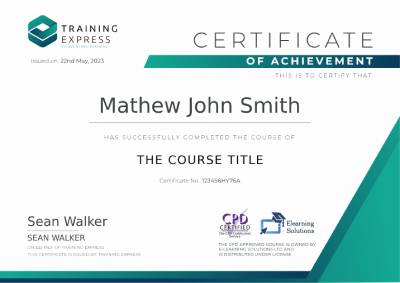GET THIS COURSE AND 1500+ OTHERS FOR ONLY £49 FIND OUT MORE
16 others bought this course in the last 24 hours!
Level 3 Health and Safety In The Workplace Training Course teaches you everything on the topic thoroughly from scratch so you can achieve a professional certificate for free to showcase your achievement in professional life. This Level 3 Health and Safety In The Workplace Course is a comprehensive, instructor-guided course designed to provide a detailed understanding of the nature of the related sector and your key roles within it.
To become successful in your profession, you must have a specific set of skills to succeed in today’s competitive world. In this in-depth training course, you will develop the most in-demand skills to kickstart your career, as well as upgrade your existing knowledge & skills. The training materials of this course are available online for you to learn at your own pace and fast-track your career with ease.
Key Features of the Level 3 Health and Safety In The Workplace Course
Our trusted, high quality and affordable Level 3 Health and Safety In The Workplace Course trains individuals to become experts in their field.
- Accredited by CPD
- Instant e-certificate and hard copy dispatch by next working day
- Fully online, interactive course with audio voiceover
- Developed by qualified professionals in the field
- Self-paced learning and laptop, tablet, smartphone-friendly
- 24/7 Learning Assistance
- Discounts on bulk purchases
Sneak Peek
Who Should Take The Level 3 Health and Safety In The Workplace Training Course
Anyone with a knack for learning new skills can take this Level 3 Health and Safety In The Workplace Training Course. While this comprehensive training is popular for preparing people for job opportunities in the relevant fields, it also helps to advance your career for promotions.
Certification
Once you’ve successfully completed your Level 3 Health & Safety In The Workplace Training course, you will immediately be sent a digital certificate. Also, you can have your printed certificate delivered by post (shipping cost £3.99). Our certifications have no expiry dates, although we do recommend that you renew them every 12 months.

Assessment
At the end of the Health & Safety In The Workplace Training Course, there will be an online assessment, which you will need to pass to complete the course. Answers are marked instantly and automatically, allowing you to know straight away whether you have passed. If you haven’t, there’s no limit on the number of times you can take the final exam. All this is included in the one-time fee you paid for the course itself.
Accreditation
All of our courses, including this Level 3 Health and Safety In The Workplace Online Training Course, are fully accredited, providing you with up-to-date skills and knowledge and helping you to become more competent and effective in your chosen field.
Course Curriculum
The detailed curriculum outline of our Level 3 Health & Safety In The Workplace Training course is as follows:
- Costs/dangers of poor health and safety
- Benefits of good health and safety
- Health and safety law (criminal law)
- Civil law – compensation claims
- Health and Safety at Work etc. Act 1974 (HSWA)
- Overlap of duties of some legislation
- Penalties and Enforcement
- Improvement and Prohibition Notices
- The Employer’s Responsibilities (Provide just the List of the duties)
- The Employee’s responsibilities and duties (Provide just the List of the duties)
- Summary
- Assessment
- Core elements of managing for health and safety
- Legal duties
- Risk profiling
- Health and safety management systems
- Documentation
- Attitudes and behaviours
- Are you doing what you need to do?
- Leading and managing for health and safety
- Competence
- Worker consultation and involvement
- Delivering Effective Arrangements
- Plan
- Do
- Check
- Act
- Summary
- Assessment
- Definitions
- 5 Steps to Risk Assessment
- Identifying hazards
- Deciding who may be harmed
- Evaluating risks
- Recording findings
- Reviewing and revising
- Who should carry out risk assessments?
- Most Common Risks at Work
- Summary
- Assessment
- RIDDOR
- Definitions
- What must be reported?
- Types of reportable injury
- Recording requirements
- First Aid at Work (requirements)
- Work-related Diseases
- Summary
- Assessment
- Emergency First Aid at Work
- Roles and Responsibilities of a worker when an incident occurs
- Dos and Don’ts in an emergency
- Questions to Ask Yourself
- What are the dangers?
- Is It Safe For You to Go Up to the Casualty?
- What Has Caused the Accident or Situation? Vc
- What Do You Think the Main Injuries Could Be?
- How to Make the Area Safe?
- How to Assess the Casualties?
- Fires
- The Elements of Fire
- Leaving a burning building
- Clothing on fire
- Smoke and fumes
- Electrical Incidents
- Caution
- Breaking contact with electricity
- High voltage current
- Low-voltage current
- Lightning
- Water Incidents
- Caution
- Rescuing a person from water
- Summary
- Assessment
- Manual Handling
- Why is dealing with manual handling important?
- Practical tips for good lifting technique
- Working at heights
- Dos and don’ts of working at height
- Working in confined spaces
- Dos and don’ts of working in confined spaces
- Vehicles at Work
- Safe movement of vehicles in the workplace
- Driving at work
- Summary
- Assessment
- General requirements for work equipment
- Hand-held tools
- Machinery hazards
- Using equipment safely
- Personal protective equipment
- Why is PPE important?
- Selection and use
- Maintenance
- Types of PPE you can use
- Emergency equipment
- Summary
- Assessment
- Slips and trips
- Why is dealing with slips and trips important?
- Practical steps to prevent slips and trips accidents
- Noise
- Measures to control noise
- Vibration
- Reducing hand-arm vibration
- Reducing whole-body vibration
- Radiations
- What are the main types of radiation?
- The hazards
- Dos and don’ts of radiation safety
- Summary
- Assessment
- Introduction
- Why Fire Safety is important
- The Importance of Fire Safety
- The Fire Triangle
- The types of fires
- Responsible Persons
- Areas with the first “Responsible Person”
- First responsible person duties
- Warden duties
- Summary
- Assessment
- Fire Safety Law
- Fire Safety Law – DSEAR
- Risk Assessments
- Fire Safety Enforcement
- Summary
- Assessment
- Fire Safety Arrangements
- Fire Extinguishers
- Fire Escape Routes
- Fire doors & Emergency ventilators
- Summary
- Assessment
- Fire Evacuation Procedures
- Personal Emergency Evacuation Plans
- Fire Evacuation
- Fire Drills
- Summary
- Assessment
- Caution
- Breaking contact with electricity
- High voltage current
- Low-voltage current
- Lightning
- Shocks
- Summary
- Assessment
- The choice and different kinds of equipment
- Inspecting equipment
- General things to look for during a visual inspection
- Inspecting the equipment
- Reducing risks: fire safety
- What must you do to ensure fire safety?
- Performing the fire safety risk assessment
- Itemised process of fire safety risk assessment
- Emergency procedures
- Call for an Emergency
- Summary
- Assessment
- Combined inspection and testing
- Types of Equipment and Tests
- The different classes of equipment
- The Earth Leakage Test
- The Touch Current Test
- IEC leads and extension leads
- PAT testers without a two-stage power lead test
- Using the IEC lead tester
- The different types of Electronic Testing Equipment
- Testing earthed and double-insulated equipment with meters
- Methods of protecting against electric shock
- Test stickers and records
- Faulty or unsuitable equipment
- Summary
- Assessment
Topics Covered in this Module Are:
- What Is Working at Height
- Examples of Working at Height
- Risks from working at height (Should start with some statistics of the UK and then mention some risks using bullet points)
- What are the most common causes of working at height?
- What do you need to consider when planning work at height?
- WAHR 2005
- How do you comply with these Regulations?
- How do you decide if someone is ‘competent’ to work at height?
- Duties
- Employer Duties
- Employee Duties
- Summary
- Assessment
- Assessing the Risks
- What Is Risk Assessment?
- Who May Be Harmed?
- What Are the Five Steps of Risk Assessment?
- How to Identify Hazards and Evaluate the Risks?
- How to Record, Review and Update the Findings?
- Preventing the Risks
- How to Reduce the Risks
- Things to consider when trying to reduce risks
- Safety Control Measures
- Control Measures for Fragile Surfaces
- Control Measures for Vehicles
- Control Measures for Roof Work
- Training
- Emergency Procedures
- Summary
- Assessment
- Selecting Work Equipment
- Personal Protective Equipment
- Safe Uses of the Common Equipment
- Mobile Scaffold
- MEWP Scissors
- MEWP Boom
- Podium Steps
- Ladder/ Step Ladder (Inspection checklist, how to secure safely)
- Hop Up
- Trestle
- Tubular Scaffold
- Inspection of Work Equipment
- Summary
- Assessment
- Definition of Conflict
- Benefits of Confrontation
- Prevention of Conflicts
- Anger Management
- Conflict Resolution Techniques
- Research
- Presentation
- Take Action
- Summary
- Assessment
- Identifying Hazardous Substances
- Dangerous Substances
- Flammable Substances
- Flammable liquids, dusts, and gases
- Asthma-Causing Substances
- Asbestos
- Lead
- Warning Labels
- Chemical Safety Data Sheets
- Emergency Procedures
- Summary
- Assessment
- Steps to Making a COSHH Assessment
- Gathering information about the substances, the work and the working practices
- Decide who will carry out the assessment
- Identify the substances present or likely to be
- Identify how the substances are hazardous
- What effects could they have?
- Who could be exposed and how?
- Evaluating the risk to health
- Evaluating risk to groups or individuals
- What is the potential of a substance for causing harm?
- What is the chance of exposure occurring?
- How often is exposure liable to occur?
- What levels are people exposed to and for how long?
- Draw conclusions about the risk to health
- When might exposure constitute a risk to health
- Recording the assessment
- When the assessment needs to be reviewed
- What Are The Basic Skills for Someone Doing an Assessment?
- Summary
- Assessment
- Selection of Measures to Prevent or Control Exposure
- Maintaining Control Measures
- Making Sure Control Measures are Used
- Plan for Emergencies
- Monitoring Exposure
- Health Surveillance
- Summary
- Assessment
- Types of Injury
- Common Disorders and Immediate Injuries
- Musculoskeletal Disorders (along with a short description of the musculoskeletal system)
- How to Prevent Disorders?
- Accident and Incident Reporting
- Summary
- Assessment
- Aims of the risk assessment (after mentioning the aims write one or two sentence about the importance)
- When should a risk assessment be conducted?
- Who should conduct a risk assessment? (what role can employees and their representatives play)
- How to conduct a workplace risk assessment (mention the steps) (identifying hazards, factors that may elevate the risk of harm, who is most at risk, who may be harmed, results of the risk assessment)
- Why is it useful to record assessment?
- Is it necessary to conduct assessment for each employee and workplace?
- How should I use the assessment
- How far should I reduce the risk
- Summary
- Assessment
- Duties of employers and employee
- How to reduce the risk of work environment?
- How to minimise the risks from incapable individual?
- Control Measures
- Safe Practices
- Personal Protective Equipment (PPE)
- LITE
- Summary
- Assessment
- Definition of Stress
- Meaning of Stress
- Understanding Stress
- How Stress Arises?
- Different Strategies to Manage stress
- Tips and Tricks for Stress Management
- Planning and Organisation
- Routine
- Be BOLD
- Summary
- Assessment
- Ergonomics and human factors
- Seating at work
- Shift work and fatigue
- Health surveillance
- Work-related stress
- Drugs and alcohol
- Violence at work
- Summary
- Assessment

SAVE 85% - OFFER ENDS SOON
£299.00Original price was: £299.00.£45.00Current price is: £45.00. ex Vat- 1 year
- Level 3
- Course Certificate
- 10 hours, 14 minutes Gift this course
Subscribe to this course and 2,000+ top‑rated Training Express courses for your organization.
Try Training Express Business- For teams of 5 or more users
- 2,000+ fresh & in-demand courses
- Learning Engagement tools
- SSO and LMS Integrations
 Food Hygiene
Food Hygiene Health & Safety
Health & Safety Safeguarding
Safeguarding First Aid
First Aid Business Skills
Business Skills Personal Development
Personal Development



